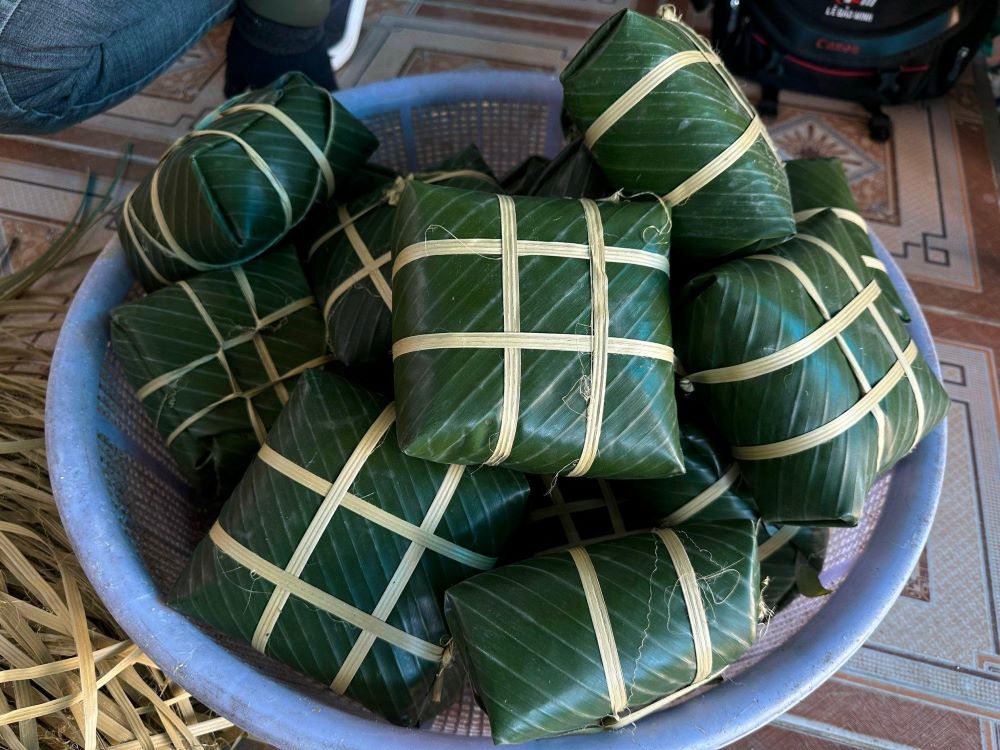From the 23rd day of Tet, when the Kitchen Gods have finished sending them off to heaven, Mom will call to ask if this year they will be using Banh Chung to burn incense so she can prepare to wrap Banh Chung for the whole family. Every year, around this time, Mom will prepare Dong leaves, Giang strings, and grind the sticky rice that the family grows to prepare to wrap Banh Chung.
In the city, where my sisters and I work and live, there are many ready-made banh chung sold. However, banh chung that my mother wrapped herself is still the “specialty” that we like. The square banh chung is wrapped from sticky rice grown and harvested by my parents, and dong leaves picked from the garden. The filling is fatty meat and mung beans, mixed with thinly sliced onions and ground pepper, creating a flavor that cannot be confused.
From the market on the 23rd day of the lunar calendar to worship the Kitchen God, my mother also bought some bamboo tubes sold at the market. My father would split these long bamboo tubes into thin strips and hang them on the stove so that the strips would be dry and chewy. Around the 27th day of the lunar calendar, my mother would wrap the cakes and cook them. The pot of cakes would be cooked for 8 to 10 hours and then taken out.
The freshly scooped cakes will be dipped in a basin of cold water, the resin washed off, then put into a mold pressed with a heavy object so that the cakes will drain, be square, and last longer. When the cakes cool, my parents will send them to my sisters and me to prepare for the altar on Tet holiday.
Holding those cakes in my hand, I remembered the same banh chung from more than 10 years ago, but the filling of this cake was made from peanuts. At that time, the family had many children, my parents were farmers, and their income depended on crops to support our four children's education. Any family that raised a pig or grew some green beans would be given priority to sell to pay for our children's school fees. So, on Tet holiday, my mother created the filling for banh chung from the peanuts she had saved.
The peanuts used for the filling are crushed and depending on taste, if you like it sweet, you will add sugar or molasses, if you like it salty, you will add salt. The green dong leaves also wrap the white sticky rice layer and then the crushed peanuts inside. After a long time of cooking, the banh chung is also chewy and has the rich taste of peanuts. Because of the difficulty, we also fought over these banh chung to eat them all with great hunger.
During these Tet holidays, the tray of food served also had fish, meat and those banh chung (square glutinous rice cakes) with peanuts. Although the plate of fish and meat was not full, for my four sisters and I, it was a real feast. Perhaps because we were still in the age of eating and growing up, everything on the tray was eaten up like a bunch of “dragons”.
Later, when life gradually improved, my sisters and I finished school and went to work. My parents' life gradually stabilized, Tet holidays gradually became more plentiful, the cupboards were full of meat and fish, and the filling for banh chung no longer required peanuts.

Nowadays, although there are countless types of banh chung fillings such as green beans, fatty meat, onions, pepper, and even salted eggs... for us, the taste of banh chung with peanut filling is still the most unforgettable. It is considered a dish of our childhood, so now every Tet holiday, when we hold in our hands the banh chung wrapped by our mother, we will remember the banh chung with peanut filling of the years gone by.
Another new year is coming, the memory of banh chung with peanuts reminds us that no matter where we are, in any circumstance, spending Tet with our loved ones and family is still precious.
Whether the Tet feast is full of meat and fish or simply a piece of banh chung with peanuts like before, it is the reunion moment that each of us looks forward to the most after a year of wandering.
(Posted in the Special Publication of Labor North Central Spring At Ty)











